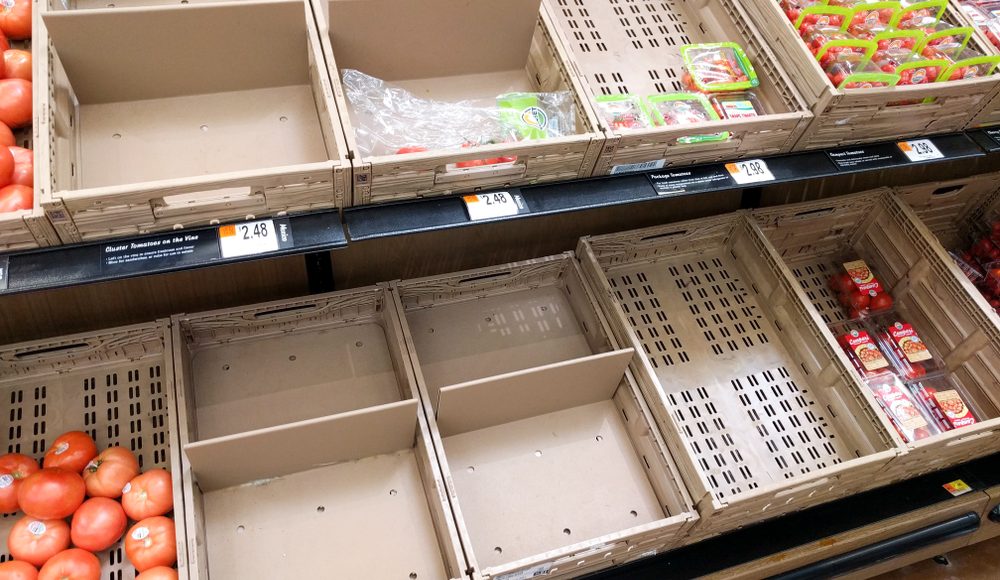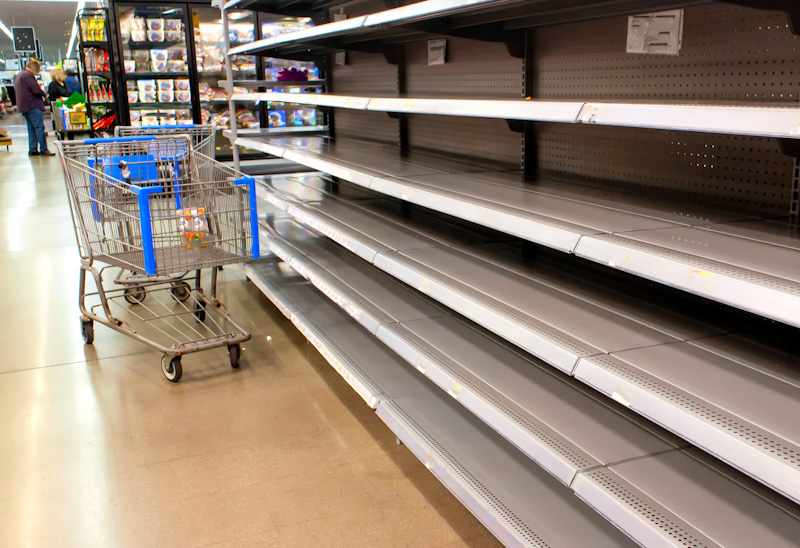The toilet paper shortages of 2020 may be behind us, but that doesn’t mean that everything is hunky-dory. Shortages continue to plague not only our land but the world as a whole. Entire industries are struggling to overcome the scarcity of parts and materials, while consumers are forced to forget about finding a good deal, settling for just the things they need.
As Americans, we are so accustomed to living in a world full of plenty that we’re a bit taken back by seeing store shelves that are poorly stocked. Even though our stores are better stocked right now than much of the world is accustomed to seeing, for us, it’s a bit hard to accept.
Yet this situation isn’t likely to change anytime soon. These are the long-term economic effects of the pandemic, which some warned about, but most of those in authority ignored. That wasn’t just here in the United States either; much of the world ignored those warnings. Because the supply chain for most products snakes its way through several countries, shutting down factories in one country can have a long-lasting impact on the other side of the world.
We weren’t the only country experiencing lockdowns in 2020. Some countries instituted them to a much greater extent than we did, to the point where people were going hungry because the food stores were closed. Our lockdowns were initiated in a rather selective manner, giving big businesses the advantage by calling them “essential” and their employees “essential workers.” While that was done mainly to keep food on people’s tables, it destroyed millions of small businesses while making the retail giants even stronger.
Now that businesses are supposedly open around the world again, we’re finding out the true impact of those lockdowns. Not only did it bankrupt millions of small businesses, but it shut down small parts manufacturers, keeping them from making the parts needed by assembly plants that manufacture the products you and I use every day. Manufacturing jobs can’t be done from home. And at the same time that was happening, there was a surge in the purchase of electronics, partly fueled by people working from home.
As of this writing, there are shortages of the following items:
- Computer chips
- Cars, including used cars and rental cars
- Gasoline
- Raw plastics
- Truck drivers
- Houses, including vacation houses
- Lumber
- Typical household and personal hygiene products
- Furniture
- Chicken, bacon, hot dogs, corn
- Imported foods
- Chlorine for swimming pools and fabric bleach
- Labor, although the unemployment rate is currently at 5.2%
- Nike shoes
- School supplies
Please note that not all of these shortages exist in all areas of the country. Likewise, I’m sure that I haven’t covered everything; there’s a good chance of a shortage of something in your area, which I have missed in this list.
Where’s this all Going?
While some might say that we Americans are spoiled and living with shortages will do us good, those shortages negatively affect the economy. Let me be clear, though; when many people hear the term “economy,” they think of major corporations and millionaires. But I’m not concerned about them; I’m worried about the average American, the ones who struggle to make ends meet every day. The people affected by a downturn in the economy are the middle class and poor, including retired people on a fixed income.
Before getting into what the market is doing to prices, let me say that our current inflation hasn’t been caused by the market forces but by the government. All those trillion-dollar-plus bills that Congress passed as “COVID relief” (and which contained a lot that wasn’t COVID relief) were paid for with money borrowed from the Federal Reserve Bank. Whenever that happens, it dilutes the value of the existing money pool, starting the inflationary cycle.
The law of supply and demand applies here. As product shortages continue, we can expect the price of those products to rise. That’s on top of already existing inflation, the highest we’ve seen in several decades. This boils down to less disposable income for families, as wages won’t increase to make up for higher prices.
We already see higher prices on some items, like lumber and meat. While the lumber industry claims that lumber prices will come back down again, it’s unlikely they’ll come back down to pre-pandemic prices. Historical data shows that when prices surge due to shortages, they rarely come back down all the way once the product is abundant.
I just recently read a report on meat prices which finally admits this, stating that the rise in meat prices we’ve seen since the beginning of COVID isn’t going to go away. If anything, we can expect to see meat prices continue to rise as costs for farmers rise as well.
Adding to the higher costs of products, shipping costs are going up as well. The global shortage of shipping is causing rising prices as well. A standard shipping container that could have been sent overseas for about $3,500 a year ago now costs $11,000 to ship. While that increase is spread out across the entire contents of that container, it’s still another addition to the product cost, adding to inflation.
That’s the thing about inflation; once prices go up on essential commodities, it forces others to raise their prices to compensate. A manufacturer of item A who has to pay more to buy material B, a product component, has to raise prices to make up for their additional costs. As they sell their products, others who need to buy them find themselves in the same predicament and raise their prices. Before long, everyone is raising their prices, causing inflation to keep growing cyclically.
If this wasn’t bad enough, we’re also looking at a worldwide shipping shortage. There is a logjam of ships sitting off the California coasts, waiting to offload. Similar sighs can be seen at many of the ports in the far east, where the ships need to be loaded. Part of the problem is that distributors are trying to make up for shortages in their warehouses caused by the lockdowns at the factories. This is causing a massive amount of orders, to the point where there are not enough shipping containers available. But those shipping containers come from a limited number of manufacturers, who can’t increase their volume.
The problem doesn’t stop there. Once the ships are offloaded, there’s a shortage of truck drivers to take those loads to their intended locations. So not only are ships stacking up offshore, containers are stacking up in US ports. It will take months, or even longer, for this all to be straightened out again.
In other words, we can expect prices to keep getting higher and higher, making it harder for us to buy the things we need.
Dealing with those Higher Prices and Product Shortages
With higher prices and product shortages a given, you and I need to figure out how we’re going to make it through the next several years without our families suffering. There are a lot of things that we can do, some conventional and some not so conventional. Each of us will have to figure out what works best for ourselves, as we each have a unique set of circumstances.
Increase Your Income
Probably the best thing that any of us can do to deal with rising costs is to increase our income. No, I’m not joking about that. While many people think that their income is outside their control, in many ways, it isn’t. You can’t control what your employer pays you, but that doesn’t mean you can’t control your income.
Today, most financial gurus will tell you that you should have multiple income streams, including some side hustle. If you depend on just your job for your income, you are highly vulnerable to what happens to that job and that company. Should the company face a downturn in its revenue, your job could be one of the victims of that downturn.
With ready access to the internet, it’s easier to start some side business than ever before. A fair number of very successful online companies began as someone’s side hustle and have now grown to the point where those people have given up their “day job,” as the revenue from their online business outgrew what they were making on the job.
Of course, it takes time to get any side business to show a profit. Don’t expect to start a YouTube channel today and be making a fortune tomorrow. As with anything else in life, the more you put into it, the more you’ll get out of it. There is no “magic” to making money online, despite what all those ads say.
If you’re already self-employed, either through a side hustle or as your full-time job, then there are always ways of increasing your income, primarily by increasing the hours you work and the number of contracts you take on. That means less free time, but then, so does running some side-hustle.
Cut Out Unnecessary Expenses
The other common thing that financial gurus talk about is cutting expenses, specifically unnecessary costs. Many tools can be used to reduce debt, reevaluate existing budgets, and make the hard decisions about what you need to spend money on and what you don’t.
Let’s be honest, though; most of us spend whatever we get. Therefore, as we find our money not going as far, there are things which we will stop spending money on or not spending as much money on. The only real difference between what the financial gurus are suggesting and what most of us do is that they are saying we should sit down and do that rationally, rather than as an impulse decision when we find that there isn’t enough money to go around. All in all, that’s a much less stressful way of going about things.
Do Things Yourself
One of my favorite ways of dealing with rising costs is doing things myself. In addition to being a survivalist, I’m a consummate do-it-yourselfer. I’ve done everything from significant remodeling jobs on my own to rebuilding my vehicle’s engine. If I don’t know how to do something, it doesn’t matter; I learn how to do it.
A generation ago, this attitude wasn’t all that uncommon. Dads taught their sons how to do a little bit of everything; carpentry, plumbing, auto mechanics, etc. While they might not be experts in any of those fields, they would at least know enough to do basic repairs. This saved the average family a lot of money, as they didn’t have to call a plumber or mechanic for the little stuff.
As one’s ability increases from doing things themselves, one can take on more significant, more complicated projects. I have some rather large projects going on right now, including replacing the 30 feet of countertop in my kitchen with an end-grain butcher block in three different types of wood. That’s going to save me a few thousand dollars over buying granite or marble and give me a unique countertop to boot.
We have to remember that any time we’re paying for something, we’re paying for a combination of materials, labor, and overhead (including profits). Considering that contractors and manufacturers typically get a better price on materials than you and I do, we’re often paying a higher percentage of that cost for labor than we are for materials. And when we do it ourselves, we’re paying ourselves the profits, not someone else.
Doing things yourself goes far beyond repairs, though. It can include making things for yourself as well. If there’s some sauce that you love to cook with, consider making your own and canning it rather than buying it. Not only will your homemade probably taste better, but it will be more nutritious as well. Just be sure to calculate your costs to make sure you’re not raising the quality to the point where it costs you more than buying does.
Don’t Wait to Buy
With the current shortages we’re experiencing, it makes a lot more sense to buy when we see an item available than wait. That’s not to say that we shouldn’t think about major purchases before committing to them. It means that when it comes to buying things that we already know we’re going to be buying, we should go but them when we can, rather than waiting.
This applies in many different places, such as things we use every day, like paper towels. But it also applies to things we might not use every day but still need regularly, like clothing for our kids. We know our kids will need school clothes for next year, so why wait until a month before school starts to buy them? It is better to buy them when they are available and on sale, buying a size that will be big enough for the next year, rather than waiting until everyone else is trying to purchase those items.
The same can be said for Christmas presents. The “Christmas shopping season” officially starts on Black Friday, the day after Thanksgiving. But what says that we have to wait till then to do our shopping? Why can’t we start shopping earlier, buying things when we see them? That will not only make sure we can get what we want, but we might manage to get them at a better price.
Utilize Your Stockpile for “Float”
One advantage we preppers have over everyone else in this time of shortages is that we already have a stockpile of food and supplies in our homes. If the stores are out of something, the rest of the world has to do without. But we don’t have to. If we have that item in our stockpile, we can always use what we have, with the intent of replacing it later.
I realize that the current situation may not look like the TEOTWAWKI event we were imagining, but all through 2020, we were talking about “the disaster of the month.” The problems we have been facing have become so pervasive that people outside the prepping community are openly speculating about the next disaster that’s going to come. That’s not conspiracy theories; it’s that people have become accustomed to facing disaster every day. The current shortages and inflation are just the latest in a long string of things we’ve had to face.
Don’t get me wrong here; I’m not suggesting that you use up your stockpile. What I’m suggesting is quite different than that. I’m suggesting that you borrow from your stash, taking note of what you’ve removed. Then, the next time you see that item, buy it and replenish your stock.
This doesn’t work if you don’t keep track of what you’ve removed. What will happen then is that you will gradually diminish what’s in your stockpile without replenishing it. The human memory isn’t all that great, and we’re all susceptible to forgetting that item if it isn’t written down; or, as I usually say it, “If it’s not written down, it doesn’t exist.” I’d instead make sure it exists so that my stockpile will continue to exist as well.










Tom MacGyver | September 28, 2021
|
I’m finding shortages of “stupid things” like club soda, which I like to add the squeezings of an orange to. I may find a shelf full of it at the store one day, only to find that shelf empty for the next two or three trips. These days, if I see a shelf full of it, I buy a bunch of bottles even if I’m not short at home. I hardly drink, but I do like a beer once in a while. The brand I like is largely unavailable due to shortages in aluminum and glass! And yes, for some reason people are panicking with the TP again.
In short, if you’re going to need it in the future, buy it NOW. Even if it’s available in the future, it’s going to be more expensive.
poorman | September 29, 2021
|
I buy almost everything on sale. If you watch prices you will see that things rotate seasonally or quarterly. One of the easiest to track is meat. Watch at the store. Chicken will be on sale one week beef another and pork another. Time this then buy 3-4 weeks worth so you are covered till the next sale. Do the same with everything else you can. if your brand of toothpaste is on sale buy 3 , same with condiments canned goods ect.. it can get a little hard at first because you are putting out more money than normal but as the savings add up ( hopefully you aren’t just spending the extra money you save ) you start to have more disposable income.
I always bough xmas presents all year. When I was younger I worked construction and as anyone who does knows it can be feast or famine . By doing this I knew my kids would have something under the tree even if we didn’t have a lot of work at the end of the year. To be honest this is how I started prepping. I did the same with staples like rice beans boxed and canned goods and when I started to do the normal 9-5 jobs I just kept it up
Ellen Whiting | September 29, 2021
|
I have developed a mindset and a spare-time hobby of preparing for hard times. This means recycling, reusing, repurposing everything imaginable; finding alternative ways to do things, learning how to do without, being less and less dependent on technology, learning more primitive skills, growing and preserving a lot of my own food, scavenging for free stuff on Craigslist, etc. It becomes an enjoyable, challenging and exciting lifestyle. There is always something new to learn, and you never know when it might come in handy.
Lisa | September 29, 2021
|
I learned to put by in the 90’s. Lean times are 2-3 months at a time. every year. I now have the summer lull too.
Am I prepper stocked?? don’t think so. Now I’m looking at if i like it, can I grow it, make it, etc.
Tired of eggs, but I own the chickens and will spend my last $$ for my animals. No $ for me, ate eggs.
As for the TP scandal. I’m stocked with reusable should I ever need it again.
FLAPrepper1 | September 29, 2021
|
Today I was looking for Windshield washer fluid, you know the blue stuff to clean the bugs off your vehicle’s windshield, my Wally World had 3 shelves of emptiness. WTH?
poorman | October 1, 2021
|
I manage an auto parts store. same for us.
Lisa | December 13, 2021
|
Yes, i regularly cruise the store for my usual brands. If it’s in, stock up. Then i won’t see it for a month, but I’m OK.
Need to add 2-3 more types of trees. It’s a bummer, my area outlawed olive trees. That is great oil.
The trouble of living farm, too near a big city. Think about what you can grow or buy in bulk.